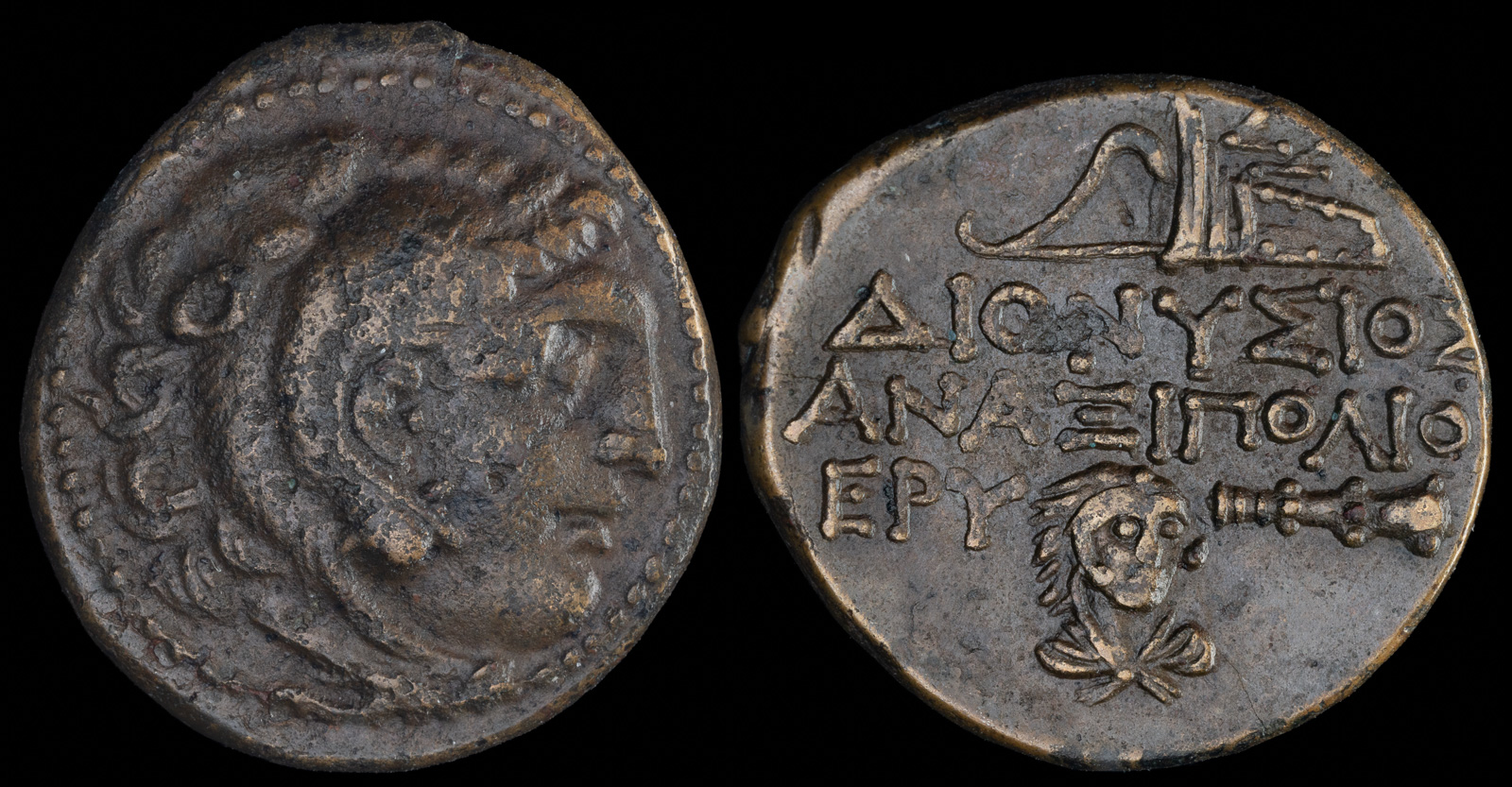
Ionia, Erythrai
Dionysios, son of Anaxipoles, magistrate
c. 260-250 BCE
Æ 21mm, 5.95g, 3h
Head of Herakles r., wearing lion skin.
R/ Bow-in-bowcase above; ΔΙΟΝΎΣΙΟΣ ΑΝΑΞΙΠΟΛΙΟΣ ΕΡΥ across centre; below, head of Herakles facing slightly r. and club
Kinns 179; SNG Copenhagen -; BMC Ionia p. 136 no. 170
Erythrai, which was located near modern day Izmir, was an important city named as one of the twelve important cities of Ionia along with Miletos, Myos, Priene, Ephesos, Kolophon, Lebedos, Teos, Klazomenai, Phokaia, Samos, and Chios.
The city was supposedly founded by Erythros, son of Radamanthys and was occupied by Lydians, Carians, and Pamphylians. Later on, Kleopos son of Kodros brought men from every Ionian city to join them.

Ionia, Erythrai
c. 4th century BCE
Æ 13mm, 1.82g, 3h
Thrasy-, magistrate
Head of Herakles r., wearing lion skin.
R/ Club and bow-in-bowcase.
SNG Copenhagen 598
Pausanias marveled at the Herakleion of Erythrai, especially the wooden statue. Legend has it that Athene sailed on a raft from Tyre and then anchored between Chios, long the rival of Erythrai, and Erythrai. Both sides wanted the statue for their own city, but the task was resolved by an Erythraian fisherman who had gone blind, but saw in a dream that the women of the city had to cut their hair to form a rope, and that rope would pull the statue in.
Most of the women weren’t fond of this dream, but the Thracian slave women agreed to do this, and a rope was constructed that was visible in Pausanias’ day. Also after that feat, the fisherman’s eyes opened and he was able to see for the rest of his life.
Pausanias also mentions a shrine of Athene in the city with a huge wooden statue.
Interestingly, this coin does not depict Athene but Herakles. The depiction of Herakles here has to do with a story you don’t typically hear on the standard “12 Labors” tour. A long time ago, in Erythrai, there was a worm that was causing havoc with the grape crops. Now some say it was in fact a serpent, and others state that it was a really big worm, but regardless, Erythrai had worm(s). Enter Herakles.
Using his unmatched strength and power, Herakles managed to defeat the worm. He may have flicked it off a leaf. He may have used the club on this coin. He may have stepped on it. We don’t truly know, but we do know that the countryside was very thankful (or merely they judged an approach on his vanity was best), but when it came down to the judges the event was not deemed worthy, for some reason, of the 12 labors.
For the coin at the top, of course I fell for the three-quarter image of Herakles facing. I must admit that I at first thought it was an image of a pirate. In fact, it would make a pretty good pirate currency IMHO.
The dating of these issues is a bit disputed. The type is mentioned in BMC Ionia as 200-133 BCE, and this magistrate is listed there. However, SEG XXXVII lists a gray blue marble base found at Erythrai with honors listed for a Dionysios son of Anaxipoles. The base is dated to the 3rd century BCE. They then mention:
a Dionysios, son of Anaxipolis, is attested as mint-master; an Anaxipolis, son of Dionysios 15 on record in |. Erythrai 201 A L. 23 (between 300-260 B.C. [is he the father of our honorand ?, Pleket]),
For this region, LGPN dates the coin to 260-250 BCE. I found no other son of Anaxipoles under the known magistrates from coins, but I did find several other Dionysios with different fathers, as well as a number of sons of Dionysios, which of course could be any of them.
The Battle of Lade is fought between the Ionians under Dionysos of Phokaia and the Persians. Chios has the largest contingent, followed by Miletos, Lesbos (probably Mytilene), Samos, Teos, Priene, Erythrai, Myos, and Phokaia. Most fled during the battle, but the Chians put up a bold resistance before defeat.
Erythrai secedes from the Delian League before Athens installs a garrison and they rejoin.
Chios, Kalchedon, Erythrai, and Klazomenai revolt against Athens and is besieged until relieved by Sparta.
Erythrai submits to Alexander the Great, who plans to create a canal on the peninsula to connect Teos to Smyrna.
April
Alexander the Great returns to Memphis and is informed that the oracles at Didama and Erythrai proclaimed him a son of Zeus.
Ptolemy I Soter gives Seleukos I Nikator a small fleet, which he uses to force Asandros to ally with Ptolemy. He also takes Erythrai and besieges Kition along with Menelaos.
Lysimachos convinces Teos and Kolophon to surrender, but Klazomenai and Erythrai are reinforced by Antigonos and are not taken.
Adramytteion, Smyrna, Sestos, Synnada, Philadelphia, Laodikeia ad Lykon, Attalaia, Erythrai, Ephesos, Perge, and Assos come under Roman control after Attalos III, the last Attalid king, leaves it to Rome in his will.